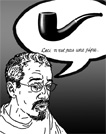So, what are the stamps all about, anyway?
So far with the Zero Sum Art Project, I've done a pretty thorough job explaining the rules of the project (see the boxed section in the middle of this page for those rules). The rules are, of course, completely arbitrary, but the experiment is only really interesting if I stick to those rules as closely as I can. But why would that be "interesting"? That points to the goals of the project, as opposed to the rules. The rules are fixed, as long as the project runs. Part of the fun is seeing what can happen within those rules - what exactly is allowed? The goals, on the other hand, may shift around a bit as I explore this terrain and see what the possibilities are. So I thought I would take a few posts over the next week or so, and explain the goals of the project as I see them at this point.
One of the goals is to create a studio environment that is as open as possible. The working process, the financial process, the progression from one image to another - all of these things will be made visible to the viewer, unlike a gallery exhibition where the selected work for view, if successful, seems to suddenly spring together as a coherent exhibition when the viewer enters the gallery. With ZSAP, you'll see all of the tangents and false starts and interesting digressions as the body of work evolves.
So, transparency, both in the pragmatic dollars and cents and the more ephemeral evolution of the artwork, is one of the projects goals. There are others that we will talk about later, but transparency is a good start. With that in mind, I thought I'd tell you about one tiny aspect of these images I've been making: the postage stamps.

You may have noticed that old postage stamps are a favorite collage element of mine. I thought I might tell you a few of the reasons I like to use them so much.
I'm a printmaker. Stamps are prints. I like the way they look, as tiny engravings, especially when they've been cancelled. A cancelled stamp is a combination of a relief print and an engraving. They are beautiful little collections of marks that add richness to an image made with pencils and brushes.
I like the color of them. The older stamps tend to be monochromatic, which make them very potent as little spots of color in a composition.
I like the fact that they are confusing in their sense of value. This echoes the whole nature of the Zero Sum Art Project - what is a thing worth? Stamps had an initial monetary value, like a piece of currency. They are cancelled, which negates their value. But people have decided that they are an interesting thing to collect, so they regain their value, perhaps many times more than their "face value", as they age and become desirable. When I insert them into an artwork, I destroy this accumulated value as a collectible, but perhaps add value to the artwork due to the visual interest of the stamps. A nice little series of additions and subtractions, mirroring the idea of taking materials that cost a certain amount of money, and using them to make "art", which, based on the "success" of the artwork, either increases or decreases the value of the materials.
I like the numbers. The postage due stamps are particularly useful here, as they are typically just a number - kind of little Jasper Johns paintings. Numbers imply sequences, and I like to use the stamps to imply a series of instructions or directions, a sense of order. One recurring theme in all of my artwork is how we make sense of things, how we create order from chaos. Eventually I'll talk about the idea of "models" as structures we use to understand the world, but suffice it to say that sequences refer to order and logic, even if that order is artificially forced on an unruly situation.
And finally, they hold a lot of nostalgic value for me, as I was a nerdy little stamp-collector as a kid. That's not an element that shows up in the artwork, but it probably is a factor in determining how they ended up being a part of the art.
So, as far as I can tell so far, that's what the postage stamps are about.


0 Comments:
Post a Comment
<< Home